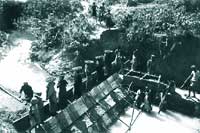| |
A NEW BEGINNING |
|
| Forging
ties
|
||
| WATER LITERACY | ||
| Informing
people Water play The facilitator Water Gala |
||
| IN FOCUS | ||
| Faulty
perceptions Thirst rises, patience evaporates |
||
| URBAN WETLANDS | ||
| Eviction
ordered Join the BIG fight Citizens pick up cudgels Solar lakes |
||
| WATER MANAGEMENT | ||
| South
India: Searching for an identity Thailand: Then came progress.... |
||
INITIATIVE |
||
| An eye
opener Naudihi’s revival Tankas of Badi Ghodan Dialogue |
||
CSE'S LATEST DESIGNS |
||
| Sri
Aurobindo Ashram’s system |
||
TECHNOLOGY |
||
| Rice
husk ash filter Clay pot irrigation |
||
| JAL YODHAS | ||
| Sachidanand
Bharti Madhu Bhatnagar |
||
TRADITION |
||
| Naullahs
of Kumaon |
||
WATER IN NEWS |
||
| Kerala,
building up its jalanidhi Schemes or scams? |
||
GREEN WATER HARVESTER'S NEWS |
||
| Saving
lives Rain associations Review |
||
CLASSROOM |
||
| Drop by
drop Water scramble |
||
FUNDING AGENCY |
||
| Oxfam
and water |
||
| 100
promises, deadline 2006 The landmarks Changing currents |
||

| Vol. 5 | No. 2 |
April-May 2003 |
||||
Atribal village Nuadihi in Mayurbhanj district of Orissa, has overcome its persisting drinking water problem by harvesting rainwater. Technical and financial support was extended to the village by a Baripada-based non-governmental organisation, Socio Economic Benevolent Action (SEBA). Today, Nuadihi has enough water to irrigate about 95 acres of the agricultural land. However, before 2000, despite receiving sufficient rains, the women had to travel more than eight kilometres to fetch water. The regeneration process began when SEBA on people’s demand decided to built a check dam across nallah (drain) to harness the excess flow. About 80 per cent of the total project cost (Rs 2.5 lakh) was borne by the Council for Advancement of People’s Action and Rural Technology (CAPART) and the rest was contributed by the community in both cash and kind. A village committee was constituted, which took charge, ensuring smooth implementation. In the first phase, both sides of the nallah were raised, so that maximum water could be stored at a minimum cost. During the second phase, a cemented weir was constructed and a five HP diesel engine was purchased to irrigate. Villagers contributed Rs 3,000 in cash and Rs 12,710 as labour. The community’s meticulous planning and active involvement has led to groundwater recharge while strengthened the community bond as well. For details:
Tankas of Badi GhodanBadi Ghodan, a remote tribal village in Udaipur district, Rajasthan, found a solution to its critical water problem by collecting roofwater in tankas. Active involvement of the people encouraged Seva Mandir, (smandir@vsnl.com) an Udaipur-based NGO, to extend technical and financial assistance. The organisation is well known for undertaking low cost community-based water conservation activities in the villages of Rajasthan. The village consists of 185 households, mostly engaged in subsistence living. Sources of drinking water are limited and often run dry as summer sets in. To solve the problem, the government installed a tubewell for drinking purposes. However, most of the families were forced to travel long distances to collect drinking water. For non-drinking purposes, the water was collected from the ponds located further ahead. The village women came up with the idea of constructing tankas. To begin with, ten tankas have been built - nine for domestic use and one for a small grocery shop. Most of the houses have handmade country tile roofing. Average area of the roof catchment is 35.7 sq m in the village. With a runoff coefficient of 0.5 to 0.6 for average annual rainfall of 625 mm, total rainwater collected from a single roof is about 12.5 cu m. The capacity of the storage tank has been designed to store 10 cu m (10,000 l) of water. However, the actual size varies (within 10 per cent deviation) with the site. About one fourth of the height of the tank protrudes above the ground to act as a courtyard. Most of these structures are dug in hard rock. Concrete cement flooring, stone slab roofing and thick stone masonry walls on the side are provided. Fillets are installed on all corners to prevent water leakage along joints. The roofwater is diverted through easily detachable PVC pipes to the tankas. Seva Mandir provided all the material input, while the users contributed in labour, ranging from 40 to 60 per cent of the total cost. The socio-economic benefits accured mostly by women are impressive. Local business is also expanding.
|
||||||
